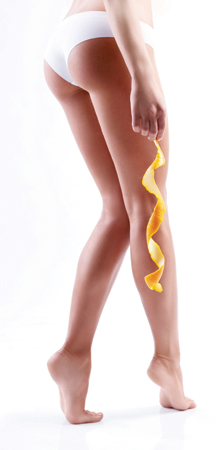Problem: Cellulite
Adiposis edematosa, dermopanniculosis deformans, gynoid lipodystrophy, and status protrusus cutis are all terms used in the medical field to describe the breach of subcutaneous fat within fibrous connective tissue that appears on the surface of the skin as dimpling and knot-like swelling. In informal, everyday terms, this skin condition is referred to as cellulite or by other more colorful colloquialisms such as hail damage, orange peel syndrome, mattress phenomenon, and cottage cheese skin.
Often found on areas of the body that experience a high accumulation of fat such as the thighs, buttocks, hips and abdomen, cellulite is the result of uneven fat deposits beneath the skin’s surface. The bumpy appearance is a result of the fat pushing up against the connective tissue, leaving the skin above it to pucker. Cellulite is not harmful, nor is it a serious medical condition; however, it can be unsightly and can cause individuals to become self-conscious. It is important to note that the presence of cellulite does not signify that a person is overweight as it can also manifest in underweight people as well.
 There are three main grades of cellulite that have been identified as a way to classify the condition. Grade 1 cellulite is asymptomatic, showing no clinical symptoms. Nevertheless, changes in the body’s anatomy can be detected when cells are examined under a microscope. Grade 2 cellulite develops when the skin experiences a reduction in elasticity, exhibits a lower skin temperature, and a pasty appearance – in addition to the changes displayed in Grade 1. Along with all of the changes described in Grades 1 and 2, Grade 3 cellulite also includes a visible, and sometimes tactile, roughness of the skin that resembles the peel of an orange.
There are three main grades of cellulite that have been identified as a way to classify the condition. Grade 1 cellulite is asymptomatic, showing no clinical symptoms. Nevertheless, changes in the body’s anatomy can be detected when cells are examined under a microscope. Grade 2 cellulite develops when the skin experiences a reduction in elasticity, exhibits a lower skin temperature, and a pasty appearance – in addition to the changes displayed in Grade 1. Along with all of the changes described in Grades 1 and 2, Grade 3 cellulite also includes a visible, and sometimes tactile, roughness of the skin that resembles the peel of an orange.
Cellulite is more common among women (mostly post-pubescent) than men. Unfortunately, the causes of cellulite are still not understood, however, several hypotheses have been developed and researched to explain this condition. Among these are hormones, such as estrogen and insulin, that are believed to play a role in the production of cellulite; genes that predispose a person to develop cellulite, such as gender, race, thickness of skin, metabolic rate, and circulatory rate; dietary choices that instigate a higher production of cellulite by eating too much fat, carbohydrates, and foods with a high salt content, not drinking enough water and eating too-little fiber also take a toll; lifestyle factors, such as smoking, lack of exercise, standing or sitting in one position for extended periods of time, and fad dieting can also contribute to fat deposits.
Case Study:
For nearly two years, one of your clients has been coming to see you for regular facial treatments. During a recent visit, she mentions a new concern: cellulite. At 34 years old, she does not have any kids, is very health conscientious, and is an avid runner. Whether it is due to genetics or the fact that she runs daily, she has always had a thin physique. Even so, her body has recently become plagued with cellulite on the outside and back of her thighs. Due to her active lifestyle, she assumed that the cause for the cellulite was more nutrition-based. Therefore, she adjusted her diet and cut back on sugars and grain-based foods. Since making this adjustment, she has not noticed an increase in cellulite. However, now she wants to work on trying to get rid of the cellulite that is present. After trying many over-the-counter creams and “miracle cures,” she is frustrated and looking for a solution to help with this stubborn problem.
As a skin care professional, what solution do you propose to treat this case study?
Solutions:
 Jessica Eckles
Jessica Eckles
clinical and practice development consultant for VIORA MD
“Having a decade of medical aesthetic experience, I have seen the long road of uncovering the challenges of our unwanted friend – the dreaded cellulite. My patient of two years just brought this up as a major concern because she has done everything she knows to rid herself of fat (for example running constantly and eating as healthy as possible). I had to explain to her that cellulite occurs in nearly 85 percent of women, whether they lead a healthy lifestyle or not. After seeing very minimal results with outdated technology through the years, I can now say I am finally confident to treat this patient and I expect great results. I will do a non-invasive series of eight, once a week treatments, using vacuum with bi-polar radio frequency heat to shrink her fat, soften the rigid connective tissue that is holding the fat hostage in those pockets, all while boosting the elasticity, in turn… smoothing everything out. She will come back for one simple treatment every three to six months and be a happy patient!”
 Pedro Dardet-Ortega
Pedro Dardet-Ortega
president of Wilma Schumann
“The client sounds like she is on a lifestyle path conducive to healthy living. Doctors have expressed that cellulite can be reduced by a good diet and exercise habits and, while this is integral to healthy skin and staying trim, sometimes cellulite is simply a genetic condition. Cellulite is caused by fat deposits that distort the connective tissues, giving it that uneven look. Supporting your exercise regimen with some good tightening creams would give the best results. Clinical studies have found that targeted tightening ingredients such as a lipolysis (fat burning) – inducing ingredient cocktail as well as the circulation benefits provided by certain botanicals, such as ginkgo biloba, guarana and caffeine, will help lift and smooth the area. Moisture is also necessary for a sleek, toned appearance, so don’t skip the lotion!”
 Nicol Sockey
Nicol Sockey
administrative director/instructor for Set-N-Me-Free Aloe Vera Co.
“This client was counseled to further change her diet to strictly organic foods; organic meats and grains and corn should be avoided. Years ago, a cattle rancher told me that prior to sending the cattle to market, they were fed grains that included chemicals to hold marbling of fat in the animal meat. When we eat the meat, our body does not break down the marbled fat any more than the animal’s body would break it down. Marbled fat is another way to say cellulite. I would recommend spa treatments that include lymphatic drainage massage and toxin cleansing body wraps scheduled four to five days apart for a series of 15 to 20 treatments followed by drinking two to three liters of water daily. At home, the client should follow up by rubbing a penetrating heat cream into the cellulite area daily. This will stimulate circulation to speed the toxin cleanse.”
 Amanda Wisth
Amanda Wisth
skin care specialist, aesthetics instructor, and makeup artist
“Inform your client that her efforts are not wasted and that roughly 90 percent of women are genetically predisposed to cellulite. Even the fitness-obsessed and naturally thin can be plagued with cottage cheese or orange peel skin. The formation of cellulite is linked to many factors and a wide range of noninvasive options are available to treat it. Supplementing her daily regimen with eight to 10 glasses of water a day and a coffee-fueled body scrub might be two of the missing pieces to her anti-cellulite puzzle. Water helps flush out toxins that hide in the fat layers beneath the skin, making cellulite lumps less visible. When used topically, caffeine delivers skin-firming, fat cell-reducing benefits by loosening toxic deposits in the adipose tissue. Massaging cellulite-stricken areas with coffee grinds can help break apart lumps beneath the skin’s surface. In addition, these scrubs leave the skin smooth and hydrated, further reducing the appearance of cellulite.”
Want to read more?
Subscribe to one of our monthly plans to continue reading this article.